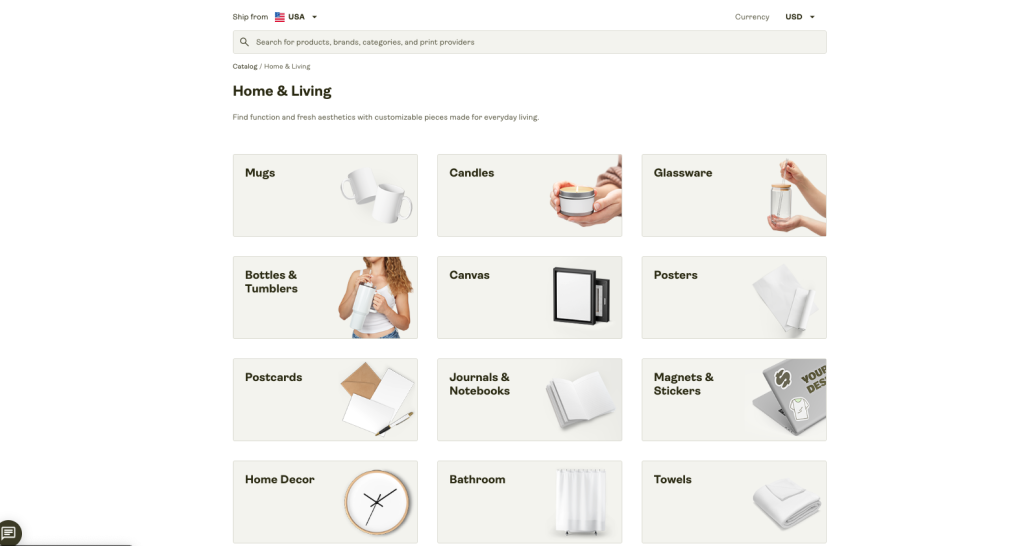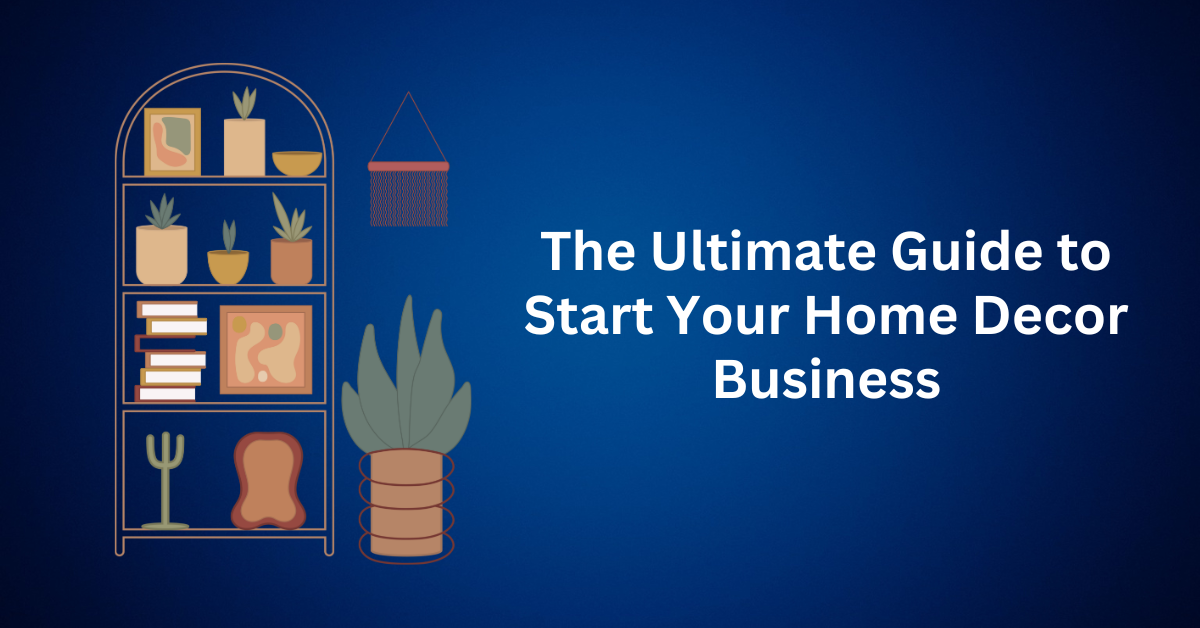Whether you’re planning to open an online store or a physical home decor shop, this guide is here to help. It walks you through the essential steps to start and grow your home décor business. Each section is carefully designed to set you up for long-term success, from building a solid business plan to choosing the right eCommerce platform.
Starting a home décor business can be a rewarding journey. With a strategic approach, you can create a brand where your unique products shine. This naturally draws in loyal customers who appreciate your style. If you’re ready to turn your passion for design into a thriving business, let’s dive in and get started!
Table of Contents
ToggleExploring the Booming Home Decor Industry
The home décor market is a dynamic and rapidly expanding sector, driven by people’s desire to craft living spaces that are both functional and visually captivating. As individuals place greater emphasis on creating environments that reflect their personalities and lifestyles, the demand for unique and innovative design solutions continues to rise.

Entrepreneurs and businesses in this space have countless opportunities, ranging from minimalist and eco-friendly styles to high-end luxury interior ventures.
Key Trends Shaping the Home Decor Market
- Personalized Touches: Homeowners are increasingly looking for ways to infuse their style into their spaces. Items such as indoor plants, custom wall art, statement mirrors, and unique furniture pieces are highly sought after for their ability to transform ordinary rooms into distinctive havens.
- Shift to Online Shopping: With the growing popularity of eCommerce, online home decor stores have become a go-to solution for shoppers seeking convenience and variety. Consumers value the ability to browse extensive collections, compare styles, and order products that align with their vision—all from the comfort of their homes.
- Sustainability and Functionality: As environmental consciousness grows, there is a rising demand for sustainable home décor products made from recycled or eco-friendly materials. Additionally, functional designs such as space-saving furniture or multi-use décor are gaining traction, especially among urban dwellers with limited living space.
Why Keeping Up with Trends is Essential
Staying informed about the latest trends in home décor is essential for building a successful business in this competitive industry. Understanding consumer preferences allows you to curate products and services that meet their needs while setting pricing strategies that balance profitability and customer satisfaction.
Keeping your offerings aligned with current trends is key to staying relevant in a rapidly evolving market. This adaptability not only boosts sales but also sets the stage for long-term success. By refreshing your product lineup and catering to emerging preferences, you position your business as a trusted, forward-thinking player in the home décor space.
Whether you’re launching a new venture or expanding an existing one, embracing innovation, personalization, and sustainability will help you stand out in this thriving industry.
How to Start a Home Decor Business: A Step-by-Step Guide
Starting a home decor business can be both rewarding and lucrative if approached strategically. Whether you’re focusing on an online store, a physical shop, or a combination of both, following a step-by-step plan will help you build a solid foundation for success.
Step 1: Create a Comprehensive Business Plan
A strong business plan serves as your roadmap, guiding every aspect of your home decor business. It outlines your objectives, strategies, market insights, and financial projections, ensuring you have a clear vision from day one.
Key Components of Your Business Plan:
- Market Research: Conduct thorough research using tools like Statista, Google Trends, or SEMrush to gain insights into market trends, consumer preferences, and competitor strategies. Understanding which home decor items are in demand such as sustainable furniture, custom wall art, or minimalist designs will help shape your offerings.
- Identify Your Target Audience: Use platforms like SurveyMonkey, Typeform, or customer segmentation tools to define your audience. Are you catering to homeowners, renters, interior designers, or DIY enthusiasts? Pinpointing your target market will allow you to tailor your products and marketing approach effectively.
- Set Business Goals and Objectives: Outline clear financial and operational goals for your first year. Tools like LivePlan or Bizplan can simplify the process with templates to help you track your progress, set revenue targets, and manage cash flow projections.
- Budget and Initial Investment: Estimate your startup costs, including inventory, website creation, branding, and marketing. Financial tools like Mint or QuickBooks can help you manage expenses and forecast your initial investment needs.
- Project Management and Workflow: Stay organized by using project management tools like Trello, Asana, or Monday.com to outline your launch timeline, assign tasks, and monitor progress.
- Choosing Online vs. Brick-and-Mortar:
Decide whether to open an online store, a physical retail space, or both. Leverage platforms like Shopify or WooCommerce for eCommerce, or research local rental spaces if opting for a physical storefront.
Step 2: Define Your Niche and Curate Your Products
The home decor industry is vast and diverse, so it’s important to narrow your focus and carve out a niche that reflects your brand’s identity. Specializing in a specific product line helps you stand out in a crowded market and allows you to target a well-defined customer base. Whether you focus on space-saving solutions for small apartments or high-end luxury furnishings for larger homes, determining your niche is key to building customer satisfaction and loyalty.

Popular Niches in the Home Decor Market
- Wall Art and Framed Prints
- Canvas prints, abstract art, and personalized wall hangings.
- Perfect for homeowners looking to add personality and style to their walls.
- Houseplants and Botanical Decor
- Indoor plants, succulents, and decorative planters.
- Appeals to eco-conscious consumers and those seeking biophilic design elements.
- Accent Accessories
- Decorative items such as candles, vases, throw pillows, and rugs.
- Ideal for customers seeking quick, affordable updates to refresh their living spaces.
- Furniture and Larger Home Furnishings
- Unique chairs, coffee tables, shelving units, and bed frames.
- Attracts customers looking for standout centerpiece items for their homes.
- Seasonal or Themed Decor
- Holiday-inspired pieces or decor tailored to specific aesthetics, like coastal, rustic, or industrial styles.
How to Source High-Quality Products
Once you’ve defined your niche, the next step is to ensure the quality of your offerings. High-quality, stylish, and durable products will help you build trust and establish a positive reputation.
- Work with Reputable Suppliers: Use platforms like Printify to connect with reliable suppliers and manufacturers. Always vet their reviews, production timelines, and return policies before committing. Printify offers a print-on-demand service so you can test out your design fast without holding a huge inventory.
- Order Product Samples: Before adding items to your inventory, request samples to assess quality firsthand. This allows you to ensure the colors, textures, and craftsmanship meet your standards.
- Invest in Customization: If your niche involves personalized products, such as custom wall art or monogrammed décor, partner with artisans or local craftspeople who specialize in customization to create unique pieces that stand out.
Quick Tip: Showcase Engaging Visuals
High-quality product photography can make or break your online home décor business. Since customers rely heavily on visuals to determine whether a product fits their aesthetic preferences, compelling images are non-negotiable. The way you present your products visually plays a critical role in influencing buying decisions and building trust with your audience.
To start, take your own photos instead of relying on generic stock images. Real-life product photography allows you to showcase the true colors, textures, and intricate details of your items, qualities that stock images simply can’t replicate. This authenticity not only builds credibility but also helps customers better understand what they’re purchasing.
Next, create styled scenes that feature your products in realistic settings, such as a cozy living room or a chic bedroom. Staging your décor items in real-life environments enables potential buyers to visualize how the product will look in their own space. This emotional connection can significantly increase the likelihood of a purchase.
Additionally, invest in professional tools to elevate the quality of your images. Use good lighting, a decent camera, and editing apps like Adobe Lightroom to refine your photos. If your budget permits, hiring a professional photographer can further enhance your brand’s visual identity and create a more polished, consistent look across your product catalog.
Ultimately, engaging visual content isn’t just a nice-to-have. It’s a cornerstone of your marketing strategy. By curating a well-photographed, niche-specific product collection, you not only capture attention but also lay a strong foundation for a thriving home décor business that resonates with your ideal customers.
Step 3: Set Up Your Online Home Decor Store
In today’s digital-first world, having a strong online presence is essential for a successful home decor business. Your eCommerce website will serve as the heart of your business, showcasing your products, attracting customers, and driving sales. Whether you build your website or leverage existing platforms, taking the time to design and optimize your online store will be critical to your success.
To Build Your Online Home Decor Store,
1. Choose an eCommerce Platform
Select a platform that aligns with your business goals and budget. Popular options include:
- Shopify: Ideal for beginners, offering user-friendly templates, apps, and a complete eCommerce toolkit.
- WooCommerce: A powerful plugin for WordPress, perfect if you want full control over your store’s customization.
- Etsy or eBay: Great for selling home décor on a ready-made marketplace with an existing audience.
- Printify: Perfect if you’re offering print-on-demand custom decor items like wall art or pillows.
These platforms allow you to get started with minimal upfront costs and provide the tools you need to manage your store effectively.
2. Design a User-Friendly Website
Your website’s design should reflect your brand and make it easy for customers to shop.
- Clean Layout: Use a minimalist design that emphasizes your product images.
- Mobile Optimization: Ensure your website looks great and functions smoothly on smartphones and tablets.
- Homepage Appeal: Feature high-quality images, a compelling value proposition, and links to bestsellers or new arrivals on your homepage.
If you’re new to website design, platforms like Shopify offer pre-designed themes that can be customized with drag-and-drop tools.
3. Create Detailed Product Listings
- Engaging Descriptions: Write product descriptions that highlight the features, benefits, and unique selling points of your items. For example, instead of simply saying “ceramic vase,” describe it as “a handcrafted ceramic vase perfect for adding an elegant touch to any living room or dining table.”
- Use Keywords: Incorporate relevant SEO keywords such as “modern home decor,” “decorative items,” or “wall art” into your descriptions to boost search rankings.
- High-Quality Images: Showcase multiple angles of each product, and if possible, include styled photos that show the items in real-life settings.
4. Set Up Payment and Shipping Options
Customers expect a seamless checkout process. Ensure your store includes:
- Secure Payment Gateways: Options like PayPal, Stripe, or Shopify Payments give customers confidence when purchasing.
- Flexible Shipping: Offer multiple shipping options, including standard and expedited delivery. Be upfront about shipping costs and estimated times.
- Clear Return Policy: Make your return process simple and transparent to build trust with customers.
5. Optimize for SEO
Search engine optimization (SEO) is vital for driving organic traffic to your store.
- Keyword Research: Use tools like SEMrush, Ahrefs, or even the Etsy search bar to find trending keywords your customers are searching for.
- Incorporate Keywords: Add relevant keywords to your product titles, descriptions, image alt texts, and meta tags. For example, instead of “Blue Pillow,” use “Modern Decorative Blue Throw Pillow for Living Rooms.”
- Create Content: Publish blog posts or guides, such as “How to Style Your Living Room with Minimalist Decor,” to attract more visitors and improve your site’s authority.
A solid SEO strategy will improve your search rankings, making it easier for customers to find your store.
By investing time and effort into building an attractive and functional online store, you’ll create a shopping experience that leaves a lasting impression on customers and sets your home decor business up for long-term success.
Step 4: Market Your Home Decor Business
Once your online store is live, the next step is to focus on promoting your brand and driving traffic to your website. Developing a well-thought-out marketing strategy is essential for reaching your target audience, building brand awareness, and converting casual browsers into loyal customers. Fortunately, the internet offers an abundance of tools and platforms to effectively advertise your home decor business, many of which are budget-friendly or even free. By leveraging these resources, you can maximize your reach and grow your business without breaking the bank.
1. Leverage Social Media Marketing
Social media platforms are visual by nature, making them perfect for showcasing home decor products.
- Instagram: Share high-quality photos of your products, styled rooms, and behind-the-scenes content. Use relevant hashtags like #HomeDecor, #InteriorDesign, and #DecorGoals to increase visibility.
- Pinterest: Create boards with themes such as “Minimalist Décor Ideas” or “Cozy Living Room Inspiration.”. Add pins that link directly to your products and use keywords to optimize for search.
- Engage with Trends: Participate in trending challenges or viral topics to make your content more discoverable. For instance, share “before and after” transformations using your décor items.
- Stories and Reels: Use Instagram Stories, Reels, or TikTok to create quick and engaging content, such as styling tips or product showcases.
2. Collaborate with Influencers
Partnering with influencers in the home decor or lifestyle niche can help you reach a broader audience and establish trust.
- Identify the Right Influencers: Look for influencers whose style aligns with your brand. Micro-influencers (10k–50k followers) often have highly engaged audiences and are more affordable than larger influencers.
- Offer Free Products: Send influencers your decor items in exchange for reviews, unboxings, or styled posts. This helps showcase your products authentically and introduces your brand to their followers.
- Affiliate Programs: Consider setting up an affiliate program where influencers earn a commission for driving sales to your store.
3. Build an Email Marketing List
Email marketing is one of the most cost-effective ways to keep your audience engaged and informed.
- Collect Email Addresses: Use pop-ups on your website to offer discounts (e.g., 10% off their first purchase) in exchange for email sign-ups.
- Regular Newsletters: Send emails announcing new product launches, sales, or special promotions. Include visually appealing content, such as product photos and styling tips, to keep your audience interested.
- Personalized Campaigns: Use tools like Mailchimp or Klaviyo to segment your email list and create tailored campaigns. For example, send “Recommended Décor for Small Spaces” to subscribers who’ve purchased apartment-friendly items.
4. Focus on Content Marketing
Content marketing helps build trust and establish your expertise in the home decor space.
- DIY Tutorials: Create step-by-step guides on topics like “How to Style a Coffee Table” or “DIY Wall Decor Ideas.”. Share these on your website, YouTube, or social media.
- Interior Design Tips: Write blog posts or create videos about trending design styles (e.g., Scandinavian, bohemian, or industrial). Include links to products in your store that fit these trends.
- Home Styling Inspiration: Share “lookbooks” that feature different room setups using your products. For instance, a blog titled “5 Ways to Create a Cozy Living Room with Minimal Effort” can inspire customers while showcasing your inventory.
- Seasonal Themes: Focus on content that aligns with seasons or holidays, such as “Fall Décor Must-Haves” or “How to Decorate for a Chic Holiday Party.”
By combining these strategies and tailoring them to your audience, you’ll create a robust marketing plan that drives traffic, builds trust, and boosts sales for your home decor business.
Step 5: Efficient Inventory Management and Order Fulfillment
Effective inventory management is vital for the success of any home decor business. As an online retailer selling physical products, it’s essential to monitor stock levels closely to avoid running out of popular items. This could result in customer dissatisfaction and missed sales opportunities. Furthermore, ensuring timely stock replenishment allows you to fulfill orders promptly. It provides a seamless shopping experience for your customers. This proactive approach not only prevents disruptions but also helps maintain customer trust and keeps your business operating smoothly.
Here are some key strategies for managing your inventory:
Utilize Inventory Management Software: Invest in tools like Ordoro or Zoho Inventory, which provide real-time tracking of your stock. These tools allow you to monitor inventory levels, receive alerts when it’s time to reorder, and manage shipments efficiently.
Partner with Dependable Suppliers: Building strong relationships with reliable suppliers ensures that your products remain available, preventing stockouts and delays in fulfilling customer orders. A consistent supply chain will also help you maintain a smooth operation and uphold your brand’s reputation.
Consider Print-on-Demand Services: To eliminate the hassle of managing inventory directly, you can take advantage of a print-on-demand service like Printify. This business model enables you to focus entirely on creating stunning designs and driving traffic to your store, while Printify’s network of partners takes care of everything from printing and packaging to shipping. This ensures your customers receive high-quality products without requiring you to manage stock or logistics. Moreover, this hands-off approach streamlines your operations and frees up valuable time. It allows you to concentrate on growing your brand and delivering an exceptional shopping experience.
Building a Strong Brand and Loyal Customer Base
When launching an online home decor store, your brand identity will set you apart from the competition. It’s essential to connect with your potential customers on a personal level by speaking to their tastes, preferences, and lifestyles in a way that resonates with them.
Craft a Consistent Brand Voice and Visual Identity
Develop a unified brand voice and visual style that reflects your values and the unique qualities of your products. Whether your brand focuses on sustainability, luxury, or minimalism, aligning your messaging with your audience’s interests fosters trust and helps build a strong connection with potential buyers.
Use Stunning Visuals to Drive Sales
High-quality product images are one of the most effective ways to showcase your offerings and solidify your brand’s identity. Consistency in your visual presentation across both your website and social media channels helps potential customers identify and connect with your brand. If you’re not a design expert, consider hiring freelancers to assist with creating visuals. Platforms like Fiverr make it easy to find talented designers who can help elevate your brand without breaking the bank.
Deliver Exceptional Customer Service
Whether you have a brick-and-mortar store or an online shop, stellar customer service is critical to your success. It’s not just about assisting customers during the shopping process; offering exceptional post-purchase support is equally important for building long-term relationships. For instance, a personal touch—such as showing genuine interest in your buyers, addressing issues quickly, or simply requesting feedback—can go a long way in creating a positive experience. Additionally, online stores with high ratings and positive reviews are more likely to attract new customers and foster trust.
By focusing on customer satisfaction, you encourage repeat business and build a solid reputation. After all, a great business idea is only successful when paired with excellent execution and a loyal, engaged audience. When you understand and serve your target market, you’ll create a base of customers who not only return but also spread the word about your brand.
Additional Effective Marketing Strategies for Your Home Decor Business
Bringing your home decor business to life involves more than just listing products and building a polished website. Once you’ve completed your market research, identified your target audience, and launched your marketing efforts, there are still several powerful strategies you can use to boost your online sales and expand your reach.
Partner with Local Businesses
Building partnerships with local businesses, such as real estate agents or interior designers, can be a mutually beneficial way to promote your home decor products. By cross-promoting your offerings, you can tap into each other’s customer base and introduce your brand to new potential buyers. This can be especially effective if you offer items that complement the services these businesses provide.
Encourage User-Generated Content
Let your customers do some of the marketing for you by encouraging them to share photos of your products in their homes. User-generated content not only helps build a sense of community around your brand, but it also provides social proof to potential customers, showcasing your decor in real-world settings. Feature these photos on your social media platforms or website to build credibility and inspire confidence in your products.
Leverage Seasonal Promotions
Holiday-themed promotions can be a great way to incentivize customers to make purchases. For example, creating bundled deals, offering limited-time discounts, or running special campaigns around major holidays—such as Christmas, Thanksgiving, or even local holidays—can effectively encourage customers to buy more while making your store feel timely and relevant. Additionally, seasonal promotions provide a natural opportunity to refresh your marketing efforts. As a result, these promotions help maintain customer engagement throughout the year.
Host Online Workshops or Webinars
Hosting webinars or virtual workshops on home decorating tips, trends, or DIY projects can effectively engage your target audience. Furthermore, it provides an opportunity to showcase your products in action. By offering valuable content, you not only educate your audience but also position yourself as an expert in the home decor space. In addition, this approach allows you to subtly promote your products within an educational setting. As a result, you can connect with potential customers on a deeper level, building trust and increasing the likelihood that purchase from you.
Additional Tips for Running a Successful Home Decor Business
As your online home decor business grows, keep these strategies in mind to enhance your chances of long-term success:
Stay Ahead of Trends
The home decor industry evolves constantly, driven by changing consumer tastes and design innovations. To stay competitive, it’s vital to keep up with current trends.
- Subscribe to leading home decor magazines such as Elle Decor, Architectural Digest, and Design Milk for expert insights on the latest styles and ideas.
- Engage with niche influencers on social media platforms like Instagram by following hashtags such as #HomeDecorTrends and #InteriorDesign.
- Use Pinterest to explore trending pins and curate boards that showcase emerging styles.
- Explore TikTok’s #HomeDecorTok to find fresh ideas from content creators who are shaping the trends.
- Regularly check marketplaces like Etsy and Amazon to see top-selling items and customer feedback, which can give you an idea of what’s resonating with buyers.
Build Strong Supplier Relationships
The strength of your supplier relationships directly impacts the success of your home decor business. Strong connections can lead to better pricing, timely deliveries, and exclusive products. To develop solid supplier partnerships, consider the following:
- Identify the types of decor you want to sell (e.g., furniture, wall art, accessories) to narrow down your search for the right suppliers.
- Use platforms like Printify, Alibaba, ThomasNet, or Maker’s Row to connect with manufacturers and wholesalers. Check reviews and ratings to ensure credibility.
- Attend home decor trade shows and events to meet suppliers face-to-face, see products in person, and forge lasting partnerships.
Once you’ve established a reliable supply chain, negotiate favourable terms: - Suppliers are often willing to offer better pricing for larger orders, which can boost your profit margins.
- Negotiate payment terms that suit both parties, such as net payment terms, which help with cash flow.
- Some suppliers may offer lower rates for bulk orders or more cost-effective shipping methods.
Automate Key Processes for Greater Efficiency
Automation is a game-changer for streamlining your business operations and allowing you to focus on growth. Implementing automation tools can handle repetitive tasks more efficiently and improve your overall business workflow:
- Email Marketing: Platforms like GetResponse allow you to automate personalized email campaigns, making it easier to nurture leads and engage existing customers.
- Stock Management: Use stock management apps such as TradeGecko to automate tracking of your inventory, ensuring that you never run low on popular items.
- Localization: Tailor your content and marketing messages for specific regions using localization tools to increase relevance and engagement with different audiences.
- Customer Support: Platforms like Zendesk offer automated customer support solutions, including chatbots and automated responses, allowing you to assist customers promptly without overwhelming your team.
By automating these essential functions, you can improve customer engagement, save time, and scale your business more efficiently.
Final Thoughts on Starting an Online Home Decor Business
Launching an online home decor business is both exciting and rewarding, especially when approached with a well-thought-out strategy. With the right plan in place, it can become a highly profitable venture. Begin by gaining a deep understanding of the industry, followed by creating a solid business plan. Leveraging the power of an online store will also help turn your passion for design into a thriving business.
To bring your home decor ideas to life, it’s essential to focus on finding your niche. By offering high-quality products and building a captivating online presence, you’ll attract customers who love your designs and are eager to buy.
Furthermore, using platforms like Printify simplifies product sourcing and order fulfillment. This significantly reduces the complexity of running an online store, allowing you to focus on what you do best, creating beautiful designs and growing your business. With the right strategy and tools in place, you’ll be on your way to building a scalable and successful home decor brand.





